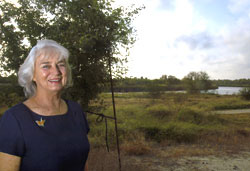 |
 |
 |
 Editorials | Environmental | December 2006 Editorials | Environmental | December 2006  
Endangered Species' Habitat Could Be Disrupted
 Karen Hastings - Dallas Morning News Karen Hastings - Dallas Morning News


| | Sue Sill, director of the North American Butterfly Park in Mission, Texas, says, "Some people have no concept of what's down here." (Brad Doherty/DMN) |
From her office just north of the Rio Grande, Sue Sill can watch with binoculars as Mexican migrants stream across an open section of U.S. border. And that's just fine with her.

The migrants are broad-tipped clearwings, red-bordered pixies and Mexican bluewings – all butterfly species rarely seen north of the river. They draw thousands of enthusiasts to the North American Butterfly Association's 100-acre riverside park every year.

But efforts to stop human migrants have Dr. Sill worried. Like other federal, state and private refuge and park managers along the country's southern edge, she is waiting to see what becomes of the border fence law signed by President Bush last month.

Refuge managers in South Texas want to remind Washington how hard they've labored in recent years to re-create a wildlife-friendly corridor through land that's been mostly cleared for agriculture and development.

These pockets of green provide a habitat for such endangered species as the ocelot and indigo snake and fuel a multimillion-dollar ecotourism industry for one of the nation's poorest regions.

"I'd hate to see a fence march across this view," said Dr. Sill from atop a low rise overlooking a reed-fringed riverbank. Behind her are 72 acres of old sorghum fields replanted in trees and butterfly habitat, along with demonstration gardens that have already posted four U.S. record butterfly sightings.

"I recognize that we need to have national security. But some people have no concept of what's down here," said Dr. Sill. "It's not just mesquite and prickly pear."

The Secure Fence Act, signed Oct. 26, authorizes 700 miles of "at least two layers of reinforced fencing" along the nation's southern border – with stretches in Texas from Laredo south to Brownsville and a short segment west of El Paso.

'Virtual fencing'

While some question whether the multibillion-dollar plan will ever be funded, the Department of Homeland Security has launched an eight-month, $67 million test of "virtual fencing" and other technology along a 28-mile border segment near Tucson, Ariz.

On behalf of the security department, the U.S. Army Corps of Engineers recently surveyed contractors capable of participating in a potential "multibillion-dollar program ... over the next five years" to include fencing, lighting and "possible environmental mitigation work."

"Our goal is full coverage of the border through a variety of tools," said homeland security spokesman Jarrod Agen. He said the agency is considering everything from "traditional fencing" to vehicle barriers, ground radar, aerial platforms and sensors. "There's not going to be one answer for the entire border."

But whether it's a "virtual" barrier of lights and sensors or a double row of razor wire-topped fence with a clear-cut no-man's-land in between, refuge managers along the tip of Texas have a strong interest in whatever crosses their land. They've begun networking to prepare for what comes next.

"Am I losing sleep? No, but I'm thinking about it a lot," said South Texas Refuge Complex manager Ken Merritt of the U.S. Fish & Wildlife Service. "We know that birds can fly over fences, but the terrestrial wildlife is going to have some problems getting back and forth."

"I'm contacting stakeholders and entering into dialogue with the Border Patrol to make sure we're at the table if it gets funded and decisions have to be made as to the fence and other infrastructure," he said. "In the meantime, we're not going to stop our efforts to acquire and restore habitat."

Key areas

By Mr. Merritt's estimate, some 275 river miles – 150 aerial miles – of habitat now run through and between federal, state and private refuge tracts in South Texas. Among the tracts:

• The Lower Rio Grande Valley National Wildlife Refuge totals some 90,000 acres across 125 tracts from Falcon Reservoir to the Gulf of Mexico. Its goal is a 132,500-acre continuous corridor along the Rio Grande, complementing city, county and privately owned greenbelts. The refuge is host to 484 species of birds and more than 300 species of butterflies.

• The federal government returns some 800 acres of South Texas refuge land each year to native brush. Just two days after Mr. Bush signed the fence bill, 800 schoolkids, Boy Scouts and other volunteers planted more than 14,000 seedlings along the river in Hidalgo County as part of this year's Rio Reforestation effort.

• The 2,000-acre Santa Ana National Wildlife Refuge near Mission, considered a hot spot for rare species seen nowhere else in the United States.

• Bentsen-Rio Grande Valley State Park near Mission, home of the World Birding Center and NABA's International Butterfly Park, are two other refuges that have collected millions of dollars in government and private grants to expand territory near the border.

"We're largely in the dark about what's going to happen next," said Carter Smith, Texas director for the Nature Conservancy, which is heavily invested in protecting the river corridor. "Any fencing or other border security measures must take into account the rich biodiversity of the Rio Grande area, from the Chihuahuan desert to Boca Chica."

Karen Hastings is a freelance writer based in Harlingen. | 
 | |
 |



